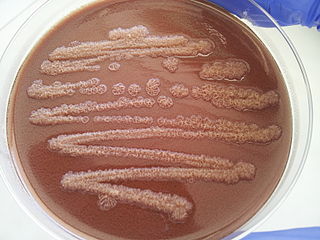Pseudomonas alcaligenes is a Gram-negative aerobic bacterium used for bioremediation purposes of oil pollution, pesticide substances, and certain chemical substances, as it can degrade polycyclic aromatic hydrocarbons. It can be a human pathogen, but occurrences are very rare. Based on 16S rRNA analysis, P. alcaligenes has been placed in the P. aeruginosa group.
Pseudomonas fragi is a psychrophilic, Gram-negative bacterium that is responsible for dairy spoilage. Unlike many other members of the genus Pseudomonas, P. fragi does not produce siderophores. Optimal temperature for growth is 30 °C, however it can grow between 0 and 35 °C. Based on 16S rRNA analysis, P. fragi has been placed in the P. chlororaphis group.
Pseudomonas caricapapayae is a Gram-negative soil bacterium that is pathogenic to plants. It was originally isolated on papaya in Brazil. Based on 16S rRNA analysis, P. caricapapayae has been placed in the P. syringae group.
Pseudomonas denitrificans is a Gram-negative aerobic bacterium that performs denitrification. It was first isolated from garden soil in Vienna, Austria. It overproduces cobalamin (vitamin B12), which it uses for methionine synthesis and it has been used for manufacture of the vitamin. Scientists at Rhône-Poulenc Rorer took a genetically engineered strain of the bacteria, in which eight of the cob genes involved in the biosynthesis of the vitamin had been overexpressed, to establish the complete sequence of methylation and other steps in the cobalamin pathway.
Pseudomonas mendocina is a Gram-negative environmental bacterium that can cause opportunistic infections, such as infective endocarditis and spondylodiscitis, although cases are very rare. It has potential use in bioremediation as it is able to degrade toluene. Based on 16S rRNA analysis, P. mendocina has been placed in the P. aeruginosa group.
Pseudomonas flavescens is a Gram-negative bacterium that causes blight cankers on walnut trees. Based on 16S rRNA analysis, P. flavescens has been placed in the P. aeruginosa group.
Pseudomonas libanensis is a Gram-negative, rod-shaped, fluorescent, motile bacterium isolated from natural springs in Lebanon. Based on 16S rRNA analysis, P. libanensis has been placed in the P. fluorescens group.
Pseudomonas mosselii is a Gram-negative, rod-shaped, bacterium clinically isolated in France. Based on 16S rRNA analysis, P. mosselii has been placed in the P. putida group.
Pseudomonas straminea is a Gram-negative, rod bacterium that includes strains formerly identified as P. ochracea. Based on 16S rRNA analysis, P. straminea has been placed in the P. aeruginosa group.
Pseudomonas monteilii is a Gram-negative, rod-shaped, motile bacterium isolated from human bronchial aspirate. P. monteilii grows in temperatures below 40 degrees Celsius. The species is capable of respiratory metabolism, but not fermentative metabolism. Laboratory observations were made on the species' production of fluorescent pigments, cytochrome oxidases, and catalases. The species is named in honor of the French microbiologist Henri Monteil.
Pseudomonas balearica is a Gram-negative, rod-shaped, nonfluorescent, motile, and denitrifying bacterium. It is an environmental bacterium that has been mostly isolated from polluted environments all over the world. Many of the isolates have demonstrated capabilities to degrade several compounds. Some of the strains are naphthalene degraders and one strain isolated in New Zealand has demonstrated the potential to oxidize inorganic sulfur compounds to tetrathionate. Based on 16S rRNA analysis, P. balearica has been placed in the P. stutzeri group.
Pseudomonas cedrina is a Gram-negative, rod-shaped bacterium isolated from spring waters in Lebanon. Based on 16S rRNA analysis, P. cedrina has been placed in the P. fluorescens group.
Pseudomonas orientalis is a Gram-negative, rod-shaped bacterium isolated from spring waters in Lebanon. Based on 16S rRNA analysis, P. orientalis has been placed in the P. fluorescens group.
Pseudomonas mandelii is a fluorescent, Gram-negative, rod-shaped bacterium isolated from natural spring waters in France. Based on 16S rRNA analysis, P. mandelii has been placed in the P. fluorescens group.
Pseudomonas migulae is a fluorescent, Gram-negative, rod-shaped bacterium isolated from natural mineral waters in France. This bacterium has also been isolated from endophytic tissues of lodgepole pine trees growing on gravel mining sites with potential to perform biological nitrogen fixation and plant growth promotion. Based on 16S rRNA analysis, P. migulae has been placed in the P. fluorescens group.
Pseudomonas gessardii is a fluorescent, Gram-negative, rod-shaped bacterium isolated from natural mineral waters in France. Based on 16S rRNA analysis, P. gessardii has been placed in the P. fluorescens group.
Pseudomonas rhodesiae is a Gram-negative, rod-shaped bacterium isolated from natural mineral waters. Based on 16S rRNA analysis, P. rhodesiae has been placed in the P. fluorescens group.

Pseudomonas stutzeri is a Gram-negative soil bacterium that is motile, has a single polar flagellum, and is classified as bacillus, or rod-shaped. While this bacterium was first isolated from human spinal fluid, it has since been found in many different environments due to its various characteristics and metabolic capabilities. P. stutzeri is an opportunistic pathogen in clinical settings, although infections are rare. Based on 16S rRNA analysis, this bacterium has been placed in the P. stutzeri group, to which it lends its name.
Pseudomonas resinovorans is a Gram-negative, soil bacterium that is commonly found in the lubricating oils of wood mills. It is able to degrade carbazole, and as such, may be used in bioremediation. Based on 16S rRNA analysis, P. resinovorans has been placed in the P. aeruginosa group.
Pseudomonas nitroreducens is an aerobic, Gram-negative soil bacterium first isolated from oil brine in Japan. It is able to synthesise polyhydroxybutyrate homopolymer from medium chain length fatty acids. Based on 16S rRNA analysis, P. nitroreducens has been placed in the P. aeruginosa group.
